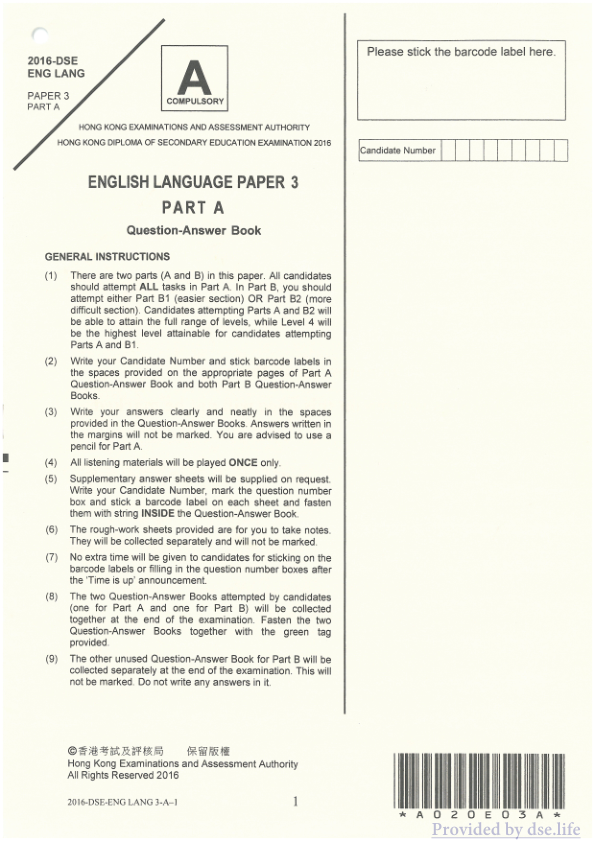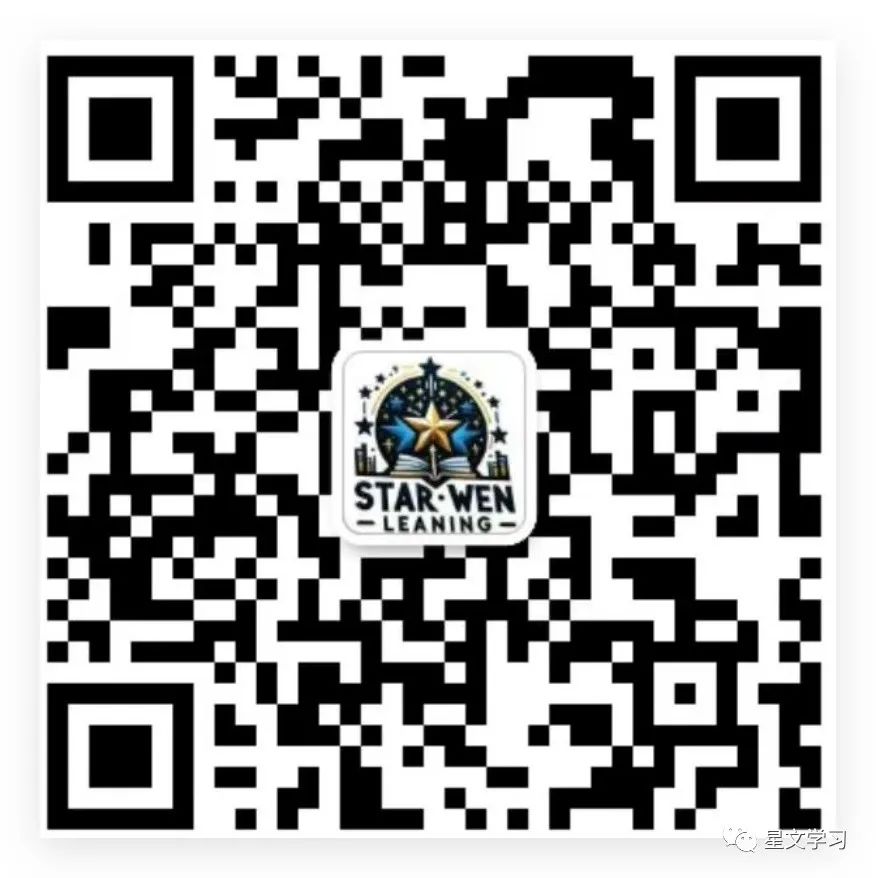2016 DSE 英国语文-English 真题 答案 详解
2016-05-05 dse dse 英国语文-English
| 序号 | 文件列表 | 说明 | ||
|---|---|---|---|---|
| 1 | 2016-英国语文-English-answer.pdf | 28 页 | 3.52MB | 答案 |
| 2 | 2016-英国语文-English-paper1.pdf | 24 页 | 17.59MB | 真题 Paper 1 |
| 3 | 2016-英国语文-English-paper2.pdf | 12 页 | 4.92MB | 真题 Paper 2 |
| 4 | 2016-英国语文-English-paper3.pdf | 37 页 | 50.54MB | 真题 Paper 3 |
| 5 | 2016-英国语文-English-paper4.pdf | 28 页 | 22.38MB | 真题 Paper 4 |
答案
MARKING SCHEMES
This document was prepared for makers' reference. It should not be regarded as a set of model answers. Candidates and teachers who were not involved in the marking process are advised to interpret its content with care.
Paper 1 (Reading)
Part A (compulsory section) 1. i) 6 [84] ii) 3 [89]
2. i) 9 [38] ii) 4 [81] iii) 2 [82] iv) 5 [72]
-
B [84]
-
C [73]
-
knocking on wood // (keeping a) rabbit's foot // lucky charm (x eliciting help from a tree god // paintings on door during Spring Festival // any examples of superstition from Text 1) [89]
6. i) T [56] ii) F [68] iii) NG [72]
-
people want to control their destiny (by warding off bad luck while enhancing the good) // people are looking for an effective way of improving the good fortune in their lives (for many centuries) // people thought luck was a strange force that could only be controlled by magical rituals and bizarre behaviour (x outdated and incorrect thinking makes superstition magical to improve good) [78]
-
D [50]
-
he thinks superstitions are outdated / irrational / unscientific // he doesn't think superstitions work / trust superstitions // he's skeptical // luck is not a magical ability or the result of random chances (x luck) [44]
-
A [49]
-
C [70]
12. i) to examine why (some) people consistently encounter chance opportunities (whereas others do not) [62] ii) questionnaire [76] iii) newspaper [83] iv) (how many) photo(graph)s (were in the newspaper) // the number of photo(graph)s / pictures (in the newspaper) [79] v) message (contained on the second page) // text [52] vi) finish faster // get spot / see / find the message / it // get the answer faster / in (a few seconds) (x count the number of photos faster / in seconds) [41] vii) they were less tense / anxious // they were more skilled / better at creating and noticing chance opportunities [44]
OR
vi) notice the unexpected // create / notice chance opportunities ... vii) their thoughts and behaviour are responsible for much of their fortune
129

真题 Paper 1
2016-DSE ENG LANG PAPER 1 PART A HONG KONG EXAMINATIONS AND ASSESSMENT AUTHORITY HONG KONG DIPLOMA OF SECONDARY EDUCATION EXAMINATION 2016 A COMPULSORY ENGLISH LANGUAGE PAPER 1 PART A Reading Passages 8:30 am - 10:00 am (1½ hours) (for both Parts A and B)
GENERAL INSTRUCTIONS
(1) There are two parts (A and B) in this paper. All candidates should attempt Part A. In Part B, you should attempt either Part B1 (easier section) OR Part B2 (more difficult section). Candidates attempting Parts A and B2 will be able to attain the full range of levels, while Level 4 will be the highest level attainable for candidates attempting Parts A and B1.
(2) After the announcement of the start of the examination, you should first write your Candidate Number and stick barcode labels in the spaces provided on the appropriate pages of the Part A Question-Answer Book and the Part B Question-Answer Book which you are going to attempt.
(3) Write your answers in the spaces provided in the Question-Answer Books. Answers written in the margins will not be marked.
(4) For multiple-choice questions, you are advised to blacken the appropriate circle with a pencil so that wrong marks can be completely erased with a clean rubber. Mark only ONE answer to each question. Two or more answers will score NO MARKS.
(5) Supplementary answer sheets will be supplied on request. Write your Candidate Number, mark the question number box and stick a barcode label on each sheet and fasten them with string INSIDE the Question-Answer Book.
(6) No extra time will be given to candidates for sticking on barcode labels or filling in the question number boxes after the 'Time is up' announcement.
(7) The two Question-Answer Books you have attempted (one for Part A and one for Part B) will be collected together at the end of the examination. Fasten the two Question-Answer Books together with the green tag provided.
(8) The unused Question-Answer Book for Part B will be collected separately at the end of the examination. This will not be marked. Do not write any answers in it.
INSTRUCTIONS FOR PART A
(1) The Question-Answer Book for Part A is inserted in this Reading Passages booklet.
(2) Attempt ALL questions in Part A. Each question carries ONE mark unless otherwise stated.
Not to be taken away before the end of the examination session
2016-DSE-ENG LANG 1-A-RP-1 9 Provided by dse.life

真题 Paper 2
2016-DSE ENG LANG PAPER 2
HONG KONG EXAMINATIONS AND ASSESSMENT AUTHORITY HONG KONG DIPLOMA OF SECONDARY EDUCATION EXAMINATION 2016
ENGLISH LANGUAGE PAPER 2 Question-Answer Book 11:00 am - 1:00 pm (2 hours) (for both Parts A and B)
INSTRUCTIONS 1. There are two parts (A and B) in this paper. Candidates should attempt Part A and ONE question from Part B. 2. After the announcement of the start of the examination, you should first write your Candidate Number in the space provided on Page 1 and stick barcode labels in the spaces provided on Pages 1, 3 and 5. 3. For Part B, you should put an 'X' in the corresponding question number box on Page 8 to indicate the question you are going to attempt. 4. Write your answers in the space provided in this Question-Answer Book. Answers written in the margins will not be marked. 5. Do not use your real name in answering any of the questions. If names are provided in the question, you must use those names. If no name is provided and you still wish to use a name to identify yourself, then use ‘Chris Wong’. If you need to use names for other characters in the composition not specified by the question, you may use names such as Mary, Peter, Mr Smith, Ms Young, etc. You may lose marks if you do not follow these instructions. 6. Rough work should be done on the rough-work sheets which will be collected separately. These will not be marked. 7. Supplementary answer sheets will be supplied on request. Write your Candidate Number, mark the question number box and stick a barcode label on each sheet and fasten them with string INSIDE this book. 8. No extra time will be given to candidates for sticking on the barcode labels or filling in the question number boxes after the ‘Time is up’ announcement.
Please stick the barcode label here. Candidate Number
2016-DSE-ENG LANG 2-1 26 AO20E002 Provided by dse.life

真题 Paper 3
2016-DSE ENG LANG PAPER 3 PART A
A COMPULSORY
HONG KONG EXAMINATIONS AND ASSESSMENT AUTHORITY HONG KONG DIPLOMA OF SECONDARY EDUCATION EXAMINATION 2016
ENGLISH LANGUAGE PAPER 3 PART A Question-Answer Book
GENERAL INSTRUCTIONS
(1) There are two parts (A and B) in this paper. All candidates should attempt ALL tasks in Part A. In Part B, you should attempt either Part B1 (easier section) OR Part B2 (more difficult section). Candidates attempting Parts A and B2 will be able to attain the full range of levels, while Level 4 will be the highest level attainable for candidates attempting Parts A and B1.
(2) Write your Candidate Number and stick barcode labels in the spaces provided on the appropriate pages of Part A Question-Answer Book and both Part B Question-Answer Books.
(3) Write your answers clearly and neatly in the spaces provided in the Question-Answer Books. Answers written in the margins will not be marked. You are advised to use a pencil for Part A.
(4) All listening materials will be played ONCE only.
(5) Supplementary answer sheets will be supplied on request. Write your Candidate Number, mark the question number box and stick a barcode label on each sheet and fasten them with string INSIDE the Question-Answer Book.
(6) The rough-work sheets provided are for you to take notes. They will be collected separately and will not be marked.
(7) No extra time will be given to candidates for sticking on the barcode labels or filling in the question number boxes after the 'Time is up' announcement.
(8) The two Question-Answer Books attempted by candidates (one for Part A and one for Part B) will be collected together at the end of the examination. Fasten the two Question-Answer Books together with the green tag provided.
(9) The other unused Question-Answer Book for Part B will be collected separately at the end of the examination. This will not be marked. Do not write any answers in it.
© Hong Kong Examinations and Assessment Authority All Rights Reserved 2016
2016-DSE-ENG LANG 3-A-1
Please stick the barcode label here.
Candidate Number
A020E03A
Provided by dse.life

真题 Paper 4
2016-DSE ENG LANG PAPER 4 EXAMINER 1.1 HONG KONG EXAMINATIONS AND ASSESSMENT AUTHORITY HONG KONG DIPLOMA OF SECONDARY EDUCATION EXAMINATION 2016 ENGLISH LANGUAGE PAPER 4 PART A Group Interaction This article appeared in a newspaper in Hong Kong: Life on HK$4 a day an eye-opener for Hong Kong students Cebu in the Philippines is best known to Hongkongers as a paradise for holidaymakers. But not far from the resorts that line the beach, hundreds of families live in hopeless poverty; their “real world” means trying to live on HK$4 a day. An international school in Hong Kong took a group of 65 students to Cebu on a one week trip to work with disadvantaged people in the Philippines. The high school students, accompanied by 20 adults, each paid HK$5000 for the trip, which included flight, accommodation, transport and meals. The first three days were spent sightseeing, snorkelling and other beach activities. The next four days were spent supporting local teachers in the classroom teaching English, maths and science. The students also helped in sustainable projects such as building houses, painting a school and serving nutritious food to children in slum communities. After the experience, one of the students said, “I had a really great time in Cebu but it was sad to see people living in poverty. We were only there for a short time and I think we were helpful. But, I wonder if we really make a difference in the long term.” One of the teachers says visiting these communities in the Philippines enables Hong Kong students to see that they live very privileged lives. They also see that the children in the Philippines are similar to them, even though their circumstances are different. Your group is discussing the kinds of charity work your school could be involved in. You may want to talk about: the benefits of students doing charity work outside Hong Kong the concerns of doing charity work outside Hong Kong whether charity work outside Hong Kong should be a requirement at secondary school anything else you think is important PART B Individual Response Have you done any charity work? Would you prefer to do charity work locally or outside Hong Kong? Do you think it’s important to give money to charity? Which is more important: to give money or your time? Do you think it is necessary to leave Hong Kong to do charity work? Should students have to pay to do charity work outside Hong Kong? Do you think charity work can make a difference? Who benefits more from charity work outside Hong Kong: the volunteers or the locals? DO NOT TAKE AWAY Provided by dse.hk 75

